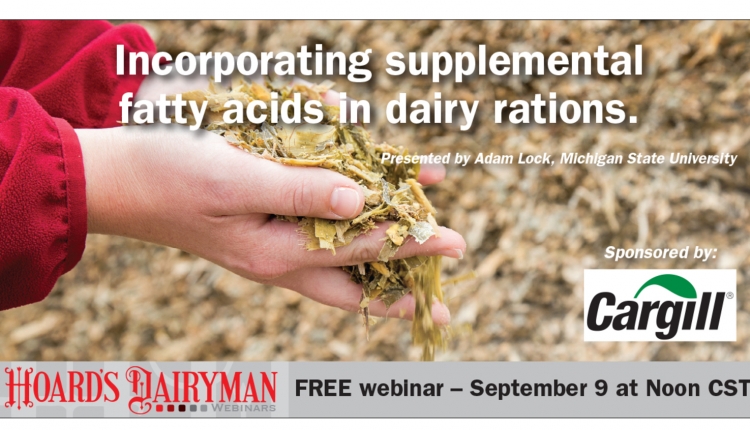
Just as each fatty acid has its own characteristics, so do fatty acid supplements. This topic was covered in the Hoard’s Dairyman monthly webinar “Incorporating supplemental fatty acids in dairy rations.” Adam Lock, Michigan State University, presented this very current topic.
The three fatty acid supplements focused on were palmitic (C16:0), stearic (C18:0), and oleic (C18:1) acids. These fatty acids play key roles in milkfat production, adipose tissue development, and metabolism. While fatty acid supplements were not designed with the cow in mind, they have been found to add value to rations even though they started as simple by-products of manufacturing industries.
Supplemental fatty acids should be fed at 1 to 1.5 percent ration dry matter. That should be above and beyond the fat content already in the ration. A blended combination of the three major fatty acids listed above has been successful in raising the neutral detergent fiber percentage in milking cow rations.
Lock’s research included evaluating the abomasum after cows were infused with oleic acid. This was intended to show the availability of nutrients prior to entering the small intestine. His findings showed an increase in total tract fatty acid digestibility.
Feeding palmitic acid supplements saw a bump in total milkfat yield. The long-term impact of supplementing palmitic acids in his research showed a dry matter intake uptick and a boost in milk production. Lock also found an improvement in body weight for oleic-supplemented cows. This was also the case for first-lactation cows as well as multiparous cows.
An interesting component of his research was that cows in early lactation responded differently than post-peak cows fed the same ration. An increase in fat yield was seen in early lactation cows fed palmitic fatty acid supplements. This was also tied to greater energy intake with the treatment.
In Lock’s research, palmitic fatty acids raised neutral detergent fiber digestibility and did not affect dry matter intake in both fresh and cows in peak lactation. However, it also induced greater body weight loss. In regard to oleic fatty acid supplementation in fresh cows, he found that those cows were less likely to mobilize body fat.
He concluded his presentation with the quote, “A bag of fat is not just a bag of fat.” His intention was to show that fatty acids have specific characteristics that serve different roles in nutrition and digestion. He encouraged listeners, “Look at the fatty acid profile.” That profile determines the response. But learning the details of the profile of supplements is not easy. Ask questions when purchasing fatty acid supplements to know exactly what you are purchasing. Not all fatty acid supplements are created equal.
To learn more, view the archived webinar. The presentation was sponsored by Cargill.
Join us next month

"How much does the welfare of people affect the welfare of animals?" will be presented by Robert Hagevoort, New Mexico State University on October 14, 2019.
Animal well-being doesn’t live in a vacuum! It begins and ends with people doing the right thing. Too often, the caretaker is taken out of the equation in animal well-being discussions, but it is the most critical component. The webinar is sponsored by the National FARM program and the Beef Quality Assurance (BQA) program.

The author is the online media manager and is responsible for the website, webinars, and social media. A graduate of Modesto Junior College and Fresno State, she was raised on a California dairy and frequently blogs on youth programs and consumer issues.








